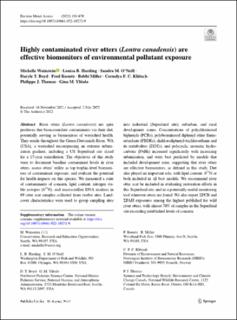Highly contaminated river otters (Lontra canadensis) are effective biomonitors of environmental pollutant exposure
| dc.contributor.author | Wainstein, Michelle | |
| dc.contributor.author | Harding, Louisa B. | |
| dc.contributor.author | O'Neill, Sandra M. | |
| dc.contributor.author | Boyd, Daryle T. | |
| dc.contributor.author | Koontz, Fred | |
| dc.contributor.author | Miller, Bobbi | |
| dc.contributor.author | Klutsch, Cornelya | |
| dc.contributor.author | Thomas, Philippe J. | |
| dc.contributor.author | Ylitalo, Gina M. | |
| dc.date.accessioned | 2022-10-07T12:49:01Z | |
| dc.date.available | 2022-10-07T12:49:01Z | |
| dc.date.created | 2022-08-19T11:57:30Z | |
| dc.date.issued | 2022-08-16 | |
| dc.identifier.citation | Environmental Monitoring & Assessment. 2022, 194 (10), . | en_US |
| dc.identifier.issn | 0167-6369 | |
| dc.identifier.uri | https://hdl.handle.net/11250/3024548 | |
| dc.description.abstract | River otters (Lontra canadensis) are apex predators that bioaccumulate contaminants via their diet, potentially serving as biomonitors of watershed health. They reside throughout the Green-Duwamish River, WA (USA), a watershed encompassing an extreme urbanization gradient, including a US Superfund site slated for a 17-year remediation. The objectives of this study were to document baseline contaminant levels in river otters, assess otters’ utility as top trophic-level biomonitors of contaminant exposure, and evaluate the potential for health impacts on this species. We measured a suite of contaminants of concern, lipid content, nitrogen stable isotopes (δ15N), and microsatellite DNA markers in 69 otter scat samples collected from twelve sites. Landcover characteristics were used to group sampling sites into industrial (Superfund site), suburban, and rural development zones. Concentrations of polychlorinated biphenyls (PCBs), polybrominated diphenyl ether flame-retardants (PBDEs), dichlorodiphenyl-trichloroethane and its metabolites (DDTs), and polycyclic aromatic hydrocarbons (PAHs) increased significantly with increasing urbanization, and were best predicted by models that included development zone, suggesting that river otters are effective biomonitors, as defined in this study. Diet also played an important role, with lipid content, δ15N or both included in all best models. We recommend river otter scat be included in evaluating restoration efforts in this Superfund site, and as a potentially useful monitoring tool wherever otters are found. We also report ΣPCB and ΣPAH exposures among the highest published for wild river otters, with almost 70% of samples in the Superfund site exceeding established levels of concern. | en_US |
| dc.language.iso | eng | en_US |
| dc.publisher | Springer Nature | en_US |
| dc.rights | Navngivelse 4.0 Internasjonal | * |
| dc.rights.uri | http://creativecommons.org/licenses/by/4.0/deed.no | * |
| dc.title | Highly contaminated river otters (Lontra canadensis) are effective biomonitors of environmental pollutant exposure | en_US |
| dc.title.alternative | Highly contaminated river otters (Lontra canadensis) are effective biomonitors of environmental pollutant exposure | en_US |
| dc.type | Peer reviewed | en_US |
| dc.type | Journal article | en_US |
| dc.description.version | publishedVersion | en_US |
| dc.rights.holder | © The Author(s) 2022 | en_US |
| dc.source.pagenumber | 25 | en_US |
| dc.source.volume | 194 | en_US |
| dc.source.journal | Environmental Monitoring & Assessment | en_US |
| dc.source.issue | 10 | en_US |
| dc.identifier.doi | 10.1007/s10661-022-10272-9 | |
| dc.identifier.cristin | 2044468 | |
| dc.source.articlenumber | 670 | en_US |
| cristin.ispublished | true | |
| cristin.fulltext | original | |
| cristin.qualitycode | 1 |
Tilhørende fil(er)
Denne innførselen finnes i følgende samling(er)
-
Divisjon for miljø og naturressurser [750]
Publikasjoner knyttet til ansatte ved Divisjon for miljø og naturressurser -
Publikasjoner fra CRIStin - NIBIO [4554]
-
Vitenskapelige artikler [1416]

